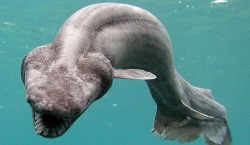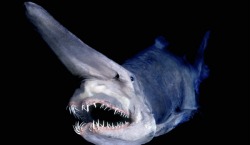|
While trawling through YouTube for more wonderful videos of underwater weirdness, I found something truly strange: a video of a Pacific Barreleye fish with a transparent head!! I just had to share it here at Show Me Something Interesting. This is the first time this particular fish has been observed alive, as the only specimens previously seen were dead, dragged to the surface by trawler nets. The first sightings were in 1939. Now, scientists can see this wonderfully strange creature alive and kicking. It is about 6 inches (15cm) long.
1 Comment
Here are two sharks, both found off the coast of Japan. What is amazing is that both are 'living fossils,' looking almost as they did in prehistoric times: in fact, many of their close relatives are already extinct. .  The first is called the Frilled Shark, so-called because of the frilly protrusions from its six gills. It has 25 rows of trident shaped, razor sharp teeth, and looks more like a giant eel than a shark. Males grow to about 1.1 meters, while females can grow to 1.5 meters. The biggest found was about 2 meters long.They normally live between 50 and 1000 meters below sea-level. On Jan 21st, 2007, the shark in the video below was found alive off the coast of Japan. It was ill, and did not adapt to being in the warmer water. It died a couple of hours later.  The second of these two wonderful creatures is called the Goblin Shark. They live about 300 - 1000 meters below sea-level, far below the warmth and light of the Sun. It hunts its prey using smell and by sensing the electrical discharges of other animals. It's head is a very unorthodox shape, but its main characteristic are its Alien-like jaws, which come out from its head. Very little is know about it, as it has only very infrequently been observed, although interestingly about 25% of its body is made up of its liver. Wow!! I'm so glad I found this. I remember watching David Attenborough's Blue Planet, and seeing the amazing sight of a bait ball of Sardines get demolished by a collaboration of sharks, dolphins, gannets and a whale. It was awesome. I don't think I had ever considered the possibility of those animals ever working together, yet here it seemed so natural. I think many people owe Mr Attenborough a debt for the work he has done educating the public about the secrets of the various non-human kingdoms. I was lucky enough to meet the man, and I have to say it was one of the best moments of my life so far. The video below is not from the Blue Planet, but it shows a similar set of events. The dolphins swin below the bait ball, blowing bubbles up to keep the sardines from swimming down too low, the sharks circle the wall, and the gannets plunge down from above. Through it all, a Brydes whale scoops up giant mouthfulss of bait. The second video has no whales, but a squadron of seals joins the army.  Deep in the depths of Florida, there is a creature that is not enjoying the best of times. I speak, of course, of the Manatee. Their closest land relatives are the Elephant and the Hyrax, and they are gentle, slow moving creatures. So what's their problem then? Well, it seems that the Manatee has a problem hearing low pitched sounds. This means that the poor creature can't hear the low pulse of the engines of the boats as they move across the water, often resulting in horrific injuries for the Manatee. Now, however, a great new idea has come to the rescue of the Manatee. By fitting high pitched alarms, which the Manatees can hear, to the bottom of the boats, the Manatees can avoid oncoming traffic, and thus avoid injury. Please visit the Save the Manatee Club website for more information about these lovely creatures. |
MOST VIEWED POSTS
© James Edward Hughes 2013
 RSS Feed
RSS Feed





